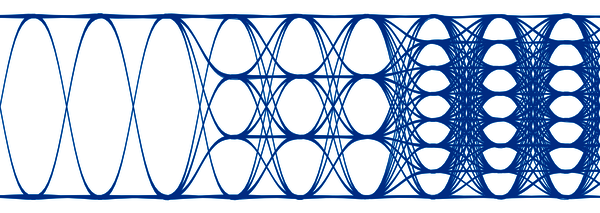Smart use of fiber networks to increase capacity
How can we employ current fiber networks in a smarter way to provide end-users with larger data rates, without having to dig trenches to add new fibers? In cooperation with fiber broadband equipment supplier Genexis, PhD student Robbert van der Linden developed several cost-efficient solutions. His research was part of the FlexCom project within the NWO-TTW Perspectief program MEMPHIS II.
In the Electrical Engineering department’s group Electro-Optical Communications, which is part of the Institute for Photonic Integration, Robbert van der Linden focused on fiber-to-the-home solutions. In these user access networks, so-called passive optical networks (PONs) connect typically 16 to 64 households to one fiber entering the street or district. There are many advantages of using PONs,’ the PhD student says. ‘You need only one fiber, and only one transceiver at the central data station per street or district. That not only saves money, but due to the large number of users connected to the station, the deployment of PONs also results in significant reductions in the space needed for the central data stations and in their power consumption.’
In theory, every connection to a single home in a PON may be equally long. In practice however, the situation often is less optimal: some of the users are very close to the central data station of the network, and others are a fair distance away. Or there might even be an extra power splitter between them and the main PON. This leads to differences in signal qualities between the different users: the closer, the higher the signal quality. Since providers want to guarantee a minimum data rate for everybody, current networks are over-dimensioned, leading to non-used overcapacity.
Proven technology
Van der Linden adopted proven technology from wireless, coax and ADSL/VDSL communication to utilize this over-capacity where it is available. He developed and tested three different methods to implement so-called adaptive modulation techniques, which match the signal parameters to the available properties of the data channels. ‘A normal signal consists of two states: a bit is either a one or a zero,’ he explains. ‘We have increased the number of states four or even eight levels. A higher number of levels implies more information per symbol, so four levels contain two bits of information, and eight levels contain three bits. This means that by implementing this fairly simple type of modulation, you can immediately transfer twice or even three times as much information in the same amount of symbols. This comes at a cost though: you need to invest more effort in decoding the signals.’

But since this method allows for a more fair allocation of capacity to the end-users, the overall throughput of the network increases significantly, he explains. ‘In contrast to for example ADSL/VDSL, the PON is shared among the users. This allows us to allocate shorter timeslots to those users nearby the central station that are able to decode the symbols with a large number of levels, thereby increasing also the performance for a user further away that can only decode symbols with a low number of levels. We have shown for a practical case of a field-installed network that it is feasible to reach an increase in throughput of 74 percent in the case of 4 levels, and up to 115 percent with eight.’
Introducing signal inequality for more equality in performance
In his second approach, Van der Linden tweaked the different signal levels a little further. ‘Normally you would go for four or eight equidistant levels. But if you position the levels with unequal intermediate spaces, you open up larger gaps between pairs of levels that are closer together. The bit encoded within the large distance is easier to decode and thus can handle a worse signal quality. Since with four levels, data can be transmitted to two users at the same time (one using the large distance gap, and one using the two smaller distances gaps), you can allocate the large distance gap to the users further away, and the smaller distance gaps to the users nearby. This effectively leads to a better overall performance.’

The third option the PhD student explored was the use of multiple wavelengths and clock rates. ‘You can send different colors of light through one fiber at the same time, combining multiple streams of data. You could even assign different clock rates to each wavelength, enabling shorter time intervals between the different symbols, and thus increasing the throughput. Currently, a new standard is being deployed which will indeed make use of four to eight different wavelengths. We have demonstrated that by using only three different clock rates, already an increase in throughput of 180 percent can be achieved.’

Contribute to societal problems
Van der Linden very much enjoyed working in a project together with industry. ‘I worked part-time at the premises of Genexis, to get acquainted with the commercial side of my research. It is very motivating to see where your research can make a useful contribution to societal problems.’
Robbert van der Linden defended his thesis entitled ‘Adaptive Modulation Techniques for Passive Optical Networks’ on Tuesday April 17th at Eindhoven University of Technology. Promotor prof.ir. A.M.J. Koonen, co-promotors dr. ir. E. Tangdiongga and N. C. Tran PhD (Genexis).
Get the last juice out
Karl Tran, Manager Future Optical Systems at Genexis: ‘We start to reach the limits of the current technologies used in broadband access networks, and we need to find out which areas we can squeeze to get the last juice out of them. An extra difficulty is that access networks are very cost sensitive: Customers demand more bandwidth, but don’t want to pay anything extra for it. Robbert has achieved a great milestone: he devised ways to increase the capacity without introducing expensive techniques by looking at the practical operational conditions. Moreover, the techniques he used are relatively simple. And since they are similar to those used before in wireless and VDSL applications, we know they can be implemented in a reliable and cost-effective way, and we can build on the experiences gained in those application areas. Every time we presented this work at conferences, we were immediately approached by multiple companies which were eager to learn more. I am convinced that these techniques will be implemented in commercial optical access networks soon.’